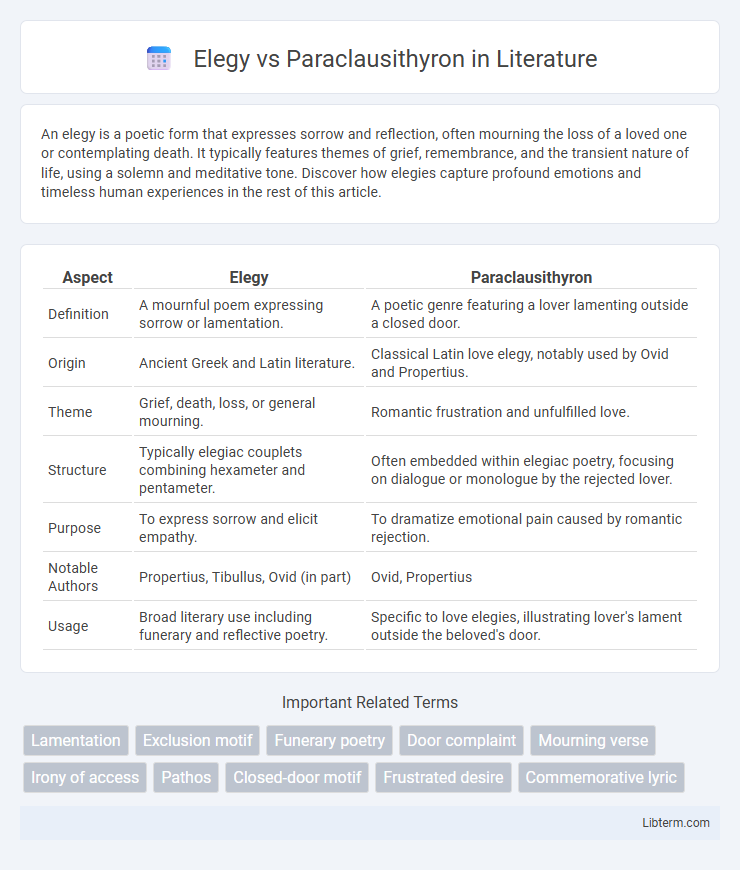An elegy is a poetic form that expresses sorrow and reflection, often mourning the loss of a loved one or contemplating death. It typically features themes of grief, remembrance, and the transient nature of life, using a solemn and meditative tone. Discover how elegies capture profound emotions and timeless human experiences in the rest of this article.
Table of Comparison
| Aspect | Elegy | Paraclausithyron |
|---|---|---|
| Definition | A mournful poem expressing sorrow or lamentation. | A poetic genre featuring a lover lamenting outside a closed door. |
| Origin | Ancient Greek and Latin literature. | Classical Latin love elegy, notably used by Ovid and Propertius. |
| Theme | Grief, death, loss, or general mourning. | Romantic frustration and unfulfilled love. |
| Structure | Typically elegiac couplets combining hexameter and pentameter. | Often embedded within elegiac poetry, focusing on dialogue or monologue by the rejected lover. |
| Purpose | To express sorrow and elicit empathy. | To dramatize emotional pain caused by romantic rejection. |
| Notable Authors | Propertius, Tibullus, Ovid (in part) | Ovid, Propertius |
| Usage | Broad literary use including funerary and reflective poetry. | Specific to love elegies, illustrating lover's lament outside the beloved's door. |
Introduction to Elegy and Paraclausithyron
Elegy is a classical poetic form characterized by its melancholic tone and elegiac couplets, often exploring themes of loss, mourning, and reflection. Paraclausithyron, a subgenre within elegy, centers on the motif of a lover lamenting outside the closed door of their beloved, symbolizing unfulfilled desire and social barriers. Both forms hold significant places in ancient Greek and Roman literature, illustrating complex emotional states through structured verses.
Defining Elegy: Meaning and Origins
Elegy, originating from ancient Greek poetry, is a melancholic or mournful poem often composed in elegiac couplets that reflect themes of loss, grief, or lamentation. It traditionally contrasts with the paraclausithyron, a genre emphasizing the motif of a lover lamenting outside a closed door, symbolizing emotional separation and unrequited love. Elegy's roots trace back to classical literature, embodying both personal sorrow and broader cultural expressions of mourning.
Understanding Paraclausithyron: Concept and History
Paraclausithyron is a poetic motif originating from ancient Greek and Roman literature, characterized by a lover lamenting outside the closed door of their beloved, symbolizing unfulfilled desire and separation. This motif contrasts with elegy, which often expresses broader themes of mourning and reflection, though both employ emotional depth and personal expression. Historical usage of Paraclausithyron highlights intimate emotional states, frequently found in Roman love elegies by poets like Propertius and Ovid, emphasizing the tension between love and rejection.
Thematic Differences Between Elegy and Paraclausithyron
Elegy traditionally explores themes of mourning, loss, and reflection on death or personal sorrow, emphasizing emotional depth and introspection. Paraclausithyron centers on the theme of frustrated love, often depicting a lover lamenting outside the closed door of their beloved, highlighting desire and separation. These thematic differences underscore elegy's broader contemplative tone contrasted with paraclausithyron's focused portrayal of romantic yearning and exclusion.
Structural Features of Elegy
Elegy traditionally consists of alternating hexameter and pentameter lines, forming elegiac couplets that create a rhythmic and melodic structure ideal for laments or reflective poetry. The structural features of elegy emphasize a balanced yet varied meter, allowing emotional depth through measured cadence and pause. This contrasts with the paraclausithyron, which is typically shorter, often formed in lyric or dramatic monologues centered on themes of separation or unrequited love without the strict metrical constraints of elegy.
Stylistic Elements of Paraclausithyron
Paraclausithyron features a distinctive stylistic element of direct address to a closed door, symbolizing emotional barriers and unrequited love, enhancing its intimate and plaintive tone. The use of vivid imagery and metaphor in Paraclausithyron heightens the sense of longing and frustration, contrasting with the more reflective and mournful style of elegy. Its concentrated emotional intensity and repetitive lamentation create a powerful rhetorical effect, emphasizing personal anguish through concise and focused language.
Famous Examples of Elegy in Literature
Elegy often explores themes of loss and mourning with notable examples such as Thomas Gray's "Elegy Written in a Country Churchyard" and John Milton's "Lycidas," both of which exemplify reflective lamentation. Paraclausithyron, a lesser-known genre centered on the theme of a lover lamenting outside a locked door, contrasts with the broader emotional scope found in elegies. The sustained popularity and critical acclaim of elegies in Western literature highlight their profound expression of grief and contemplation over mortality.
Notable Paraclausithyron Instances in Poetry
Notable paraclausithyron instances in poetry often highlight themes of longing and separation, exemplified in Ovid's "Amores," where the poet laments being barred from his lover's door, encapsulating emotional vulnerability. Catullus also employs paraclausithyron in his verses, using the motif of a locked gate to symbolize unfulfilled desire and romantic frustration. These poetic instances use vivid imagery and emotional depth to emphasize the tension between physical barriers and passionate yearning.
Influence on Later Literary Genres
Elegy, characterized by its mournful tone and themes of loss, profoundly influenced the development of pastoral poetry and the Romantic tradition by embedding personal emotion within structured verse. Paraclausithyron, an ancient motif portraying lovers lamenting a closed door, shaped the evolution of lyrical poetry and the motif of unrequited love, deeply resonating in Renaissance sonnets and Elizabethan drama. Both forms established foundational emotional expressions that permeated later genres, enhancing narrative depth and thematic complexity.
Conclusion: Elegy vs Paraclausithyron Compared
Elegy and paraclausithyron both explore themes of loss and longing but differ significantly in structure and emotional focus. Elegy typically combines reflection with mourning, often expanding on broader human experiences of grief. Paraclausithyron centers on the specific moment of romantic rejection, emphasizing immediate emotional intensity and desire for reunion.
Elegy Infographic

 libterm.com
libterm.com